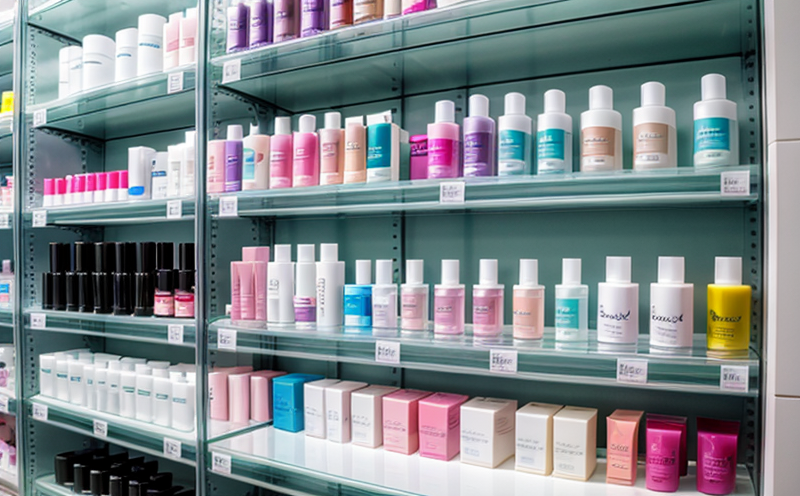Shelf Life Testing under Different Climate Zones
In the cosmetics industry, ensuring that products maintain their quality and efficacy over time is paramount. Shelf life testing is a critical component of this process. This service provides comprehensive evaluation of cosmetic formulations in various climate zones to ensure product stability and shelf life compliance with international standards.
The purpose of shelf life testing involves determining the duration for which a cosmetic formulation retains its original characteristics, including texture, color, scent, and performance attributes. This is achieved through controlled environmental conditions that mimic different climate zones around the globe. By subjecting samples to these conditions, we can identify any potential degradation or changes in product quality.
Our team of experts uses state-of-the-art equipment to conduct these tests rigorously following international standards such as ISO 7218 and ASTM D5490. The testing process involves replicating real-world conditions experienced by cosmetics during storage, transportation, and use. This includes temperature variations, humidity levels, light exposure, and other factors that may influence the stability of cosmetic products.
The results from these tests are invaluable for quality managers, compliance officers, R&D engineers, and procurement teams who rely on accurate data to make informed decisions regarding product formulation, packaging design, and storage protocols. Understanding how different climate zones impact a cosmetic product’s shelf life allows companies to optimize their supply chain strategies and enhance consumer trust.
For instance, products intended for tropical regions might require different packaging materials or additional preservatives compared to those meant for colder climates. Additionally, knowing the optimal temperature range for storage can significantly extend the shelf life of sensitive formulations like serums or moisturizers containing active ingredients susceptible to thermal degradation.
In summary, shelf life testing under varying climate zones is an essential step in ensuring product quality and safety throughout its lifecycle. It helps manufacturers stay compliant with regulatory requirements while also improving overall customer satisfaction by delivering consistent results across diverse markets.
Why It Matters
The importance of shelf life testing cannot be overstated, especially in the cosmetics sector where consumer trust plays a crucial role. Customers expect their favorite products to perform consistently over time without losing efficacy or developing harmful contaminants. Therefore, accurate shelf life testing is not only regulatory compliance but also a commitment to customer satisfaction and safety.
Product stability under different climate conditions ensures that consumers receive consistent quality regardless of where they purchase the product. For manufacturers operating internationally, understanding how various climates affect their products allows them to tailor marketing messages accordingly. It also helps in designing packaging solutions that can protect against specific environmental stresses, thereby extending shelf life and maintaining product integrity.
Moreover, regulatory bodies worldwide enforce stringent guidelines concerning cosmetic safety and efficacy. Non-compliance with these regulations can lead to product recalls, legal penalties, and damage to brand reputation. By investing in thorough shelf life testing across different climates, companies demonstrate their dedication to meeting these standards and protecting public health.
In conclusion, effective shelf life testing contributes significantly towards maintaining a positive image among consumers while ensuring strict adherence to global regulations. It is an investment that pays dividends through enhanced product quality and consumer confidence.
Scope and Methodology
The scope of our shelf life testing service encompasses the evaluation of cosmetic formulations under simulated climate conditions that represent different regions across the globe. This includes tropical, temperate, and arctic climates to cover a wide range of environmental factors such as temperature fluctuations, humidity levels, and light exposure.
Our methodology involves selecting appropriate test samples based on their intended use and market distribution. Samples are then exposed to controlled environments that replicate specific climate zones for predetermined periods. Throughout the testing process, we monitor various parameters including color change, texture alteration, odor modification, and overall stability of active ingredients.
The equipment used in our laboratory adheres strictly to international standards such as ISO 7218 and ASTM D5490. This ensures consistency and accuracy in our findings. Our team of experienced analysts employs advanced analytical techniques to analyze samples at regular intervals throughout the testing period, ensuring that any changes or degradation are detected promptly.
Upon completion of each test series, detailed reports are generated summarizing all observations made during the experiment. These reports provide valuable insights into how different climate zones affect cosmetic products and offer recommendations for optimizing product performance based on these findings.
Industry Applications
| Climatic Zone | Main Application | Key Considerations |
|---|---|---|
| Tropical Climate (e.g., Singapore) | Sunscreen stability and SPF retention | High humidity and intense sunlight exposure may affect sunscreen efficacy. |
| Temperate Climate (e.g., Germany) | Mascara formulation integrity and color consistency | Varying temperature ranges can impact mascara’s viscosity and pigment dispersion. |
| Arctic Climate (e.g., Finland) | Lip balm texture preservation | Rapid cooling and thawing cycles could lead to lip balm separation or hardening issues. |
The diverse applications of shelf life testing under different climate zones highlight its significance in ensuring product quality across various market segments. For example, in tropical climates like Singapore, sunscreen stability becomes a critical factor due to high humidity and intense sunlight exposure which might affect the SPF retention over time. In temperate regions such as Germany, mascara formulation integrity is crucial because varying temperature ranges can impact the viscosity of the product and its ability to evenly disperse pigments. Meanwhile, in arctic climates like Finland, maintaining the texture of lip balms becomes paramount since rapid cooling and thawing cycles could result in separation or hardening issues.





